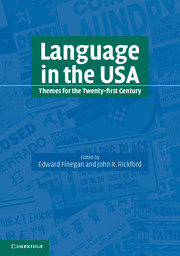Book contents
- Frontmatter
- Contents
- List of figures
- List of tables
- List of contributors
- Acknowledgments
- Foreword
- Editors' preface
- Part 1 American English
- Part 2 Other language varieties
- 7 Multilingualism and non-English mother tongues
- 8 Creole languages: forging new identities
- 9 Native American languages
- 10 Spanish in the Northeast
- 11 Spanish in the Southwest
- 12 American Sign Language
- 13 Asian American voices: language in the Asian American community
- 14 Linguistic diversity and English language acquisition
- Part 3 The sociolinguistic situation
- Index
14 - Linguistic diversity and English language acquisition
Published online by Cambridge University Press: 05 June 2012
- Frontmatter
- Contents
- List of figures
- List of tables
- List of contributors
- Acknowledgments
- Foreword
- Editors' preface
- Part 1 American English
- Part 2 Other language varieties
- 7 Multilingualism and non-English mother tongues
- 8 Creole languages: forging new identities
- 9 Native American languages
- 10 Spanish in the Northeast
- 11 Spanish in the Southwest
- 12 American Sign Language
- 13 Asian American voices: language in the Asian American community
- 14 Linguistic diversity and English language acquisition
- Part 3 The sociolinguistic situation
- Index
Summary
Editors' introduction
It is a notable and surprising fact that among residents of the USA nearly one in five persons aged five or above reports speaking a language other than English at home. Equally notable and possibly more surprising is the fact that more than half of those reporting that they use a language other than English at home also report that they know English and speak it very well. In this chapter, Robert Bayley provides a wealth of information about the range of languages spoken in the USA and the growing linguistic diversity prompted by immigration, about the difficulties of learning English in some communities and in some situations, about the continuing strong pattern of language shift from immigrant languages to English, and about the challenge that immigrant communities face in maintaining their heritage languages. You will find surprises on nearly every page of this chapter because much of what residents of the USA know – or think we know – about the use of English and other languages in the USA is partly or entirely wrong.
In this chapter you will discover how many residents of the USA who speak languages other than English have enrolled in ESL classes in recent years and what age groups they come from. You will note historical patterns about the use of English among US immigrants and their children, and you will see that among the barriers that keep eager potential students of English from enrolling in ESL classes are a shortage of such classes and of qualified teachers for them, a lack of time or financial resources, the demands of child care, and a lack of transportation.
- Type
- Chapter
- Information
- Language in the USAThemes for the Twenty-first Century, pp. 268 - 286Publisher: Cambridge University PressPrint publication year: 2004
- 8
- Cited by

